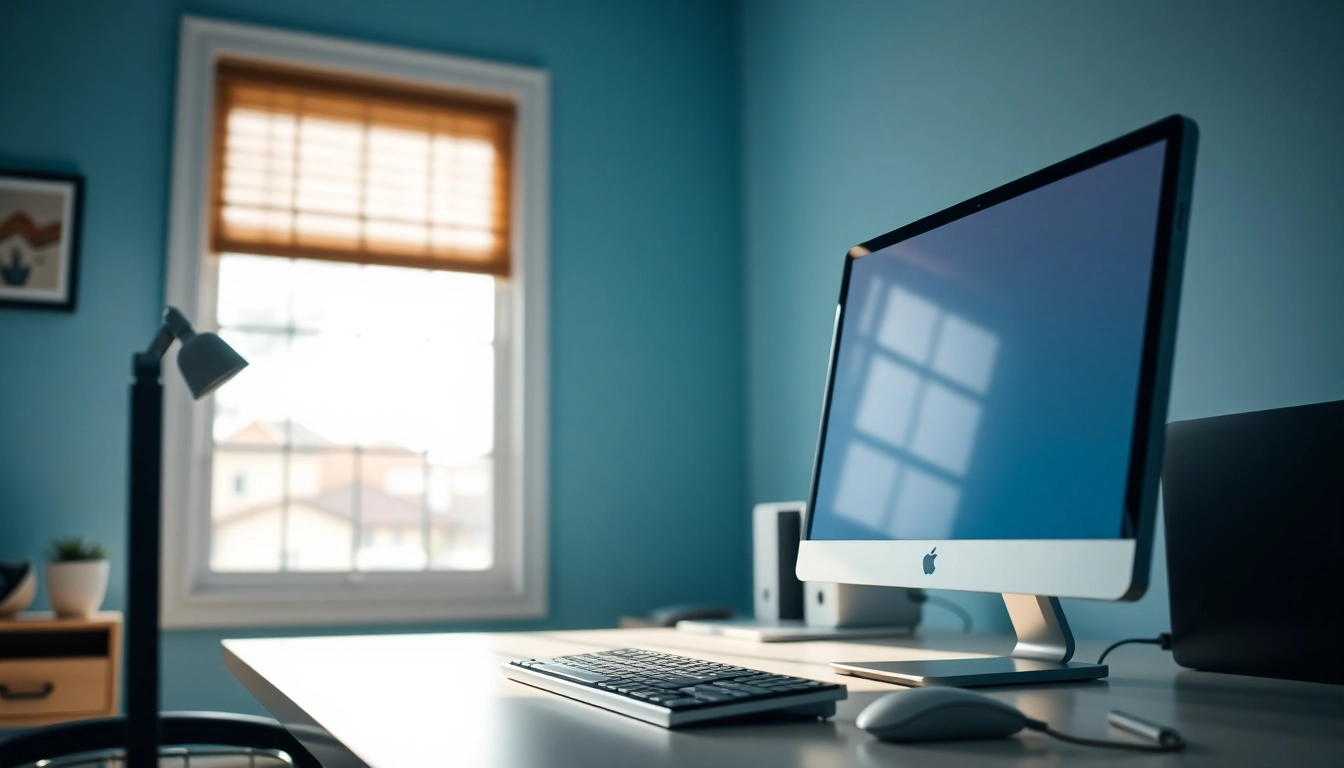
Mastering the Dual Monitor Install: Step-by-Step Guide to Boost Your Workflow
Understanding Dual Monitor Install Basics
In today’s fast-paced digital environment, a dual monitor install has quickly become a standard setup for both professionals and enthusiasts. Utilizing two screens allows for increased productivity, efficient multitasking, and a more versatile workspace. Whether you’re a gamer, a graphic designer, a stock trader, or simply working from home, harnessing the power of dual monitors can significantly enhance your workflow. If you’re ready to embrace this technology, here’s a comprehensive guide on how to install dual monitors effectively. You can find more information on dual monitor install services and installation tips.
What You Need for a Dual Monitor Setup
Before diving into the installation process, it’s crucial to determine what equipment you will need. A successful dual monitor setup requires:
- Two Monitors: These can be identical or different in specifications such as screen size, resolution, and display technology (LED, LCD, etc.).
- Connection Cables: Depending on your monitor’s ports, you’ll need the correct cables. Common types include HDMI, DisplayPort, VGA, and DVI.
- Graphics Card: Ensure your computer’s graphics card supports multiple displays. This is essential for setting up your dual monitors.
- Monitor Stand or Mount: Consider investing in a mount if you’d like to save desk space or adjust the alignment and angles of your monitors for better ergonomics.
- Power Strips and Cables: Make sure you have enough power sources for both monitors to avoid a cluttered workspace.
Compatibility: Is Your Computer Ready?
Compatibility is the cornerstone of a successful dual monitor installation. Check your computer specifications and ensure your operating system supports multiple monitors. Most modern operating systems like Windows 10, Windows 11, and macOS seamlessly integrate multiple displays. A quick check involves:
- Visiting your computer’s display settings.
- Checking the specifications of your graphics card on the manufacturer’s website to confirm dual monitor support.
- Ensuring your operating system is up to date, which barely affects compatibility but includes better support and features for multiple displays.
Types of Connections: HDMI, DisplayPort, and More
Understanding the different types of connections is important, as they can impact performance and quality:
- HDMI: The most common type for monitors; it carries both audio and video signals.
- DisplayPort: Similar to HDMI but can support higher resolutions and refresh rates.
- VGA: An older standard that might still be found on some monitors and PCs. It is best for lower resolutions.
- DVI: Mainly found on older graphics cards, it can also support high resolution but does not carry audio.
How to Physically Connect Dual Monitors
Step-by-Step Guide to Connecting Monitors
Once you’ve gathered all the necessary equipment, follow these steps to physically connect your monitors:
- Power Down: Turn off your computer and unplug it to ensure safety during installation.
- Connect Monitors: Use the appropriate cables to connect each monitor to the computer. Make sure each connection is secure.
- Power On: Plug your computer back in and power it up. At this stage, both monitors should light up, indicating they are connected.
Common Connection Issues and Solutions
Even with the right equipment and steps, connection issues can arise. Here are some common challenges and how to troubleshoot them:
- Monitor Not Detected: If one of your monitors isn’t recognized, check the cables for secure connections and ensure both monitors are powered on.
- Incorrect Display Settings: Sometimes the system defaults to one display. Navigate to the display settings and select ‘Extend these displays’ to use both monitors.
- Resolution Problems: Ensure both monitors are set to their native resolutions for optimal performance through the display settings menu.
Testing Your Setup for Success
After connecting the monitors, it’s essential to test them to ensure they’re functioning correctly:
- Drag windows between screens to confirm they’re configured properly.
- Adjust display settings to optimize visuals, such as brightness, contrast, and color calibration.
- Run a graphics performance test to check for any lag or unusual behavior.
Configuring Display Settings for Optimal Use
Windows Display Settings Overview
For users operating on Windows, the process to configure display settings is straightforward:
- Select Start > Settings > System > Display.
- Here, you can see both monitors represented as icons. You can identify which is which by clicking on ‘Identify.’
- Choose how you want to use your second display: Mirror, Extend, or Second screen only.
Mac Display Configuration
If you’re using a Mac, configuring dual monitors is equally simple:
- Click on the Apple menu and select System Preferences > Displays.
- Click the ‘Arrangement’ tab to arrange the displays as desired, dragging them in the layout you’re using.
- Check the ‘Mirror Displays’ box if you want the same content on both screens, or leave it unchecked to extend the desktop.
Advanced Features: Screen Mirroring vs. Extending
Understanding the difference between screen mirroring and extending is crucial for maximizing your productivity:
- Screen Mirroring: Both monitors display the same content. This is useful for presentations or when sharing your screen with multiple viewers.
- Extending Displays: Each monitor acts as an extension of your desktop, allowing for more screen real estate and better multitasking capabilities. This setup is preferred for work environments.
Enhancing Productivity with Dual Monitors
Organizing Your Workspace Efficiently
With the physical setup behind you, it’s time to optimize your workspace. Here are some tips:
- Consider ergonomics: Position your monitors at eye level and ensure they’re an arm’s length away.
- Use monitor stands to adjust height and angles for improved posture.
- Keep frequently used applications positioned on the primary monitor and less used applications on the secondary display.
Recommended Software for Multi-Monitor Setups
Software can enhance the usability of your dual monitor setup:
- DisplayFusion: Offers powerful features for multi-monitor setups, such as customizable hotkeys and multi-monitor wallpapers.
- Ultramon: Provides additional taskbars for secondary displays and enables easy window management.
- Actual Multiple Monitors: A feature-rich tool that allows for better organization and management across multiple screens.
Common Productivity Challenges and Solutions
Even with dual monitors, challenges may arise:
- Distraction: Having two screens can lead to more distractions. Focus on making a dedicated workspace and utilize apps to limit distractions.
- Window Management: If applications often disappear or open in the wrong monitor, consider software that enhances window management and shortcuts.
- Fatigue: Prolonged use can lead to eye fatigue. Use blue light filtering glasses or software to minimize strain, and take regular breaks.
Troubleshooting Common Dual Monitor Issues
Resolving Display Recognition Problems
If a monitor is not being detected by your system, here are some potential solutions:
- Check all connections to ensure they are secure.
- Try rebooting your computer.
- Access display settings to manually set the monitor as active.
Adjusting Display Colors and Resolutions
Incorrect color settings can lead to an unpleasant viewing experience. Adjust colors by:
- Accessing display settings.
- Selecting individual monitors and customizing brightness, contrast, and color settings as needed.
- Using calibration tools that come with the operating systems or third-party applications to fine-tune display quality.
When to Seek Professional Assistance
While many issues can be solved independently, certain situations may warrant professional help:
- Hardware malfunctions that are beyond basic troubleshooting.
- Setting up specialized hardware for gaming or professional-grade graphics needs.
- Network issues involving high-definition streaming across multiple monitors.
By following the detailed steps and advice laid out in this guide, you can maximize the benefits of a dual monitor setup, streamline your workflow, and tap into an array of productivity-enhancing features.
